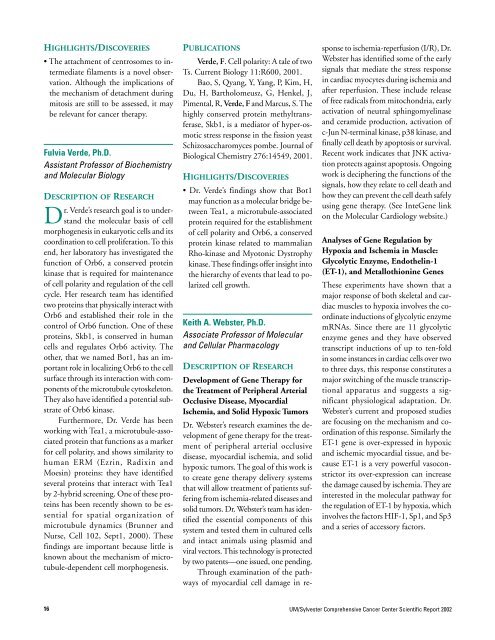tumor cell biology program - Sylvester Comprehensive Cancer Center
tumor cell biology program - Sylvester Comprehensive Cancer Center
tumor cell biology program - Sylvester Comprehensive Cancer Center
Create successful ePaper yourself
Turn your PDF publications into a flip-book with our unique Google optimized e-Paper software.
HIGHLIGHTS/DISCOVERIES<br />
• The attachment of centrosomes to intermediate<br />
filaments is a novel observation.<br />
Although the implications of<br />
the mechanism of detachment during<br />
mitosis are still to be assessed, it may<br />
be relevant for cancer therapy.<br />
Fulvia Verde, Ph.D.<br />
Assistant Professor of Biochemistry<br />
and Molecular Biology<br />
DESCRIPTION OF RESEARCH<br />
Dr. Verde’s research goal is to understand<br />
the molecular basis of <strong>cell</strong><br />
morphogenesis in eukaryotic <strong>cell</strong>s and its<br />
coordination to <strong>cell</strong> proliferation. To this<br />
end, her laboratory has investigated the<br />
function of Orb6, a conserved protein<br />
kinase that is required for maintenance<br />
of <strong>cell</strong> polarity and regulation of the <strong>cell</strong><br />
cycle. Her research team has identified<br />
two proteins that physically interact with<br />
Orb6 and established their role in the<br />
control of Orb6 function. One of these<br />
proteins, Skb1, is conserved in human<br />
<strong>cell</strong>s and regulates Orb6 activity. The<br />
other, that we named Bot1, has an important<br />
role in localizing Orb6 to the <strong>cell</strong><br />
surface through its interaction with components<br />
of the microtubule cytoskeleton.<br />
They also have identified a potential substrate<br />
of Orb6 kinase.<br />
Furthermore, Dr. Verde has been<br />
working with Tea1, a microtubule-associated<br />
protein that functions as a marker<br />
for <strong>cell</strong> polarity, and shows similarity to<br />
human ERM (Ezrin, Radixin and<br />
Moesin) proteins: they have identified<br />
several proteins that interact with Tea1<br />
by 2-hybrid screening. One of these proteins<br />
has been recently shown to be essential<br />
for spatial organization of<br />
microtubule dynamics (Brunner and<br />
Nurse, Cell 102, Sept1, 2000). These<br />
findings are important because little is<br />
known about the mechanism of microtubule-dependent<br />
<strong>cell</strong> morphogenesis.<br />
PUBLICATIONS<br />
Verde, F. Cell polarity: A tale of two<br />
Ts. Current Biology 11:R600, 2001.<br />
Bao, S, Qyang, Y, Yang, P, Kim, H,<br />
Du, H, Bartholomeusz, G, Henkel, J,<br />
Pimental, R, Verde, F and Marcus, S. The<br />
highly conserved protein methyltransferase,<br />
Skb1, is a mediator of hyper-osmotic<br />
stress response in the fission yeast<br />
Schizosaccharomyces pombe. Journal of<br />
Biological Chemistry 276:14549, 2001.<br />
HIGHLIGHTS/DISCOVERIES<br />
• Dr. Verde’s findings show that Bot1<br />
may function as a molecular bridge between<br />
Tea1, a microtubule-associated<br />
protein required for the establishment<br />
of <strong>cell</strong> polarity and Orb6, a conserved<br />
protein kinase related to mammalian<br />
Rho-kinase and Myotonic Dystrophy<br />
kinase. These findings offer insight into<br />
the hierarchy of events that lead to polarized<br />
<strong>cell</strong> growth.<br />
Keith A. Webster, Ph.D.<br />
Associate Professor of Molecular<br />
and Cellular Pharmacology<br />
DESCRIPTION OF RESEARCH<br />
Development of Gene Therapy for<br />
the Treatment of Peripheral Arterial<br />
Occlusive Disease, Myocardial<br />
Ischemia, and Solid Hypoxic Tumors<br />
Dr. Webster’s research examines the development<br />
of gene therapy for the treatment<br />
of peripheral arterial occlusive<br />
disease, myocardial ischemia, and solid<br />
hypoxic <strong>tumor</strong>s. The goal of this work is<br />
to create gene therapy delivery systems<br />
that will allow treatment of patients suffering<br />
from ischemia-related diseases and<br />
solid <strong>tumor</strong>s. Dr. Webster’s team has identified<br />
the essential components of this<br />
system and tested them in cultured <strong>cell</strong>s<br />
and intact animals using plasmid and<br />
viral vectors. This technology is protected<br />
by two patents—one issued, one pending.<br />
Through examination of the pathways<br />
of myocardial <strong>cell</strong> damage in response<br />
to ischemia-reperfusion (I/R), Dr.<br />
Webster has identified some of the early<br />
signals that mediate the stress response<br />
in cardiac myocytes during ischemia and<br />
after reperfusion. These include release<br />
of free radicals from mitochondria, early<br />
activation of neutral sphingomyelinase<br />
and ceramide production, activation of<br />
c-Jun N-terminal kinase, p38 kinase, and<br />
finally <strong>cell</strong> death by apoptosis or survival.<br />
Recent work indicates that JNK activation<br />
protects against apoptosis. Ongoing<br />
work is deciphering the functions of the<br />
signals, how they relate to <strong>cell</strong> death and<br />
how they can prevent the <strong>cell</strong> death safely<br />
using gene therapy. (See InteGene link<br />
on the Molecular Cardiology website.)<br />
Analyses of Gene Regulation by<br />
Hypoxia and Ischemia in Muscle:<br />
Glycolytic Enzyme, Endothelin-1<br />
(ET-1), and Metallothionine Genes<br />
These experiments have shown that a<br />
major response of both skeletal and cardiac<br />
muscles to hypoxia involves the coordinate<br />
inductions of glycolytic enzyme<br />
mRNAs. Since there are 11 glycolytic<br />
enzyme genes and they have observed<br />
transcript inductions of up to ten-fold<br />
in some instances in cardiac <strong>cell</strong>s over two<br />
to three days, this response constitutes a<br />
major switching of the muscle transcriptional<br />
apparatus and suggests a significant<br />
physiological adaptation. Dr.<br />
Webster’s current and proposed studies<br />
are focusing on the mechanism and coordination<br />
of this response. Similarly the<br />
ET-1 gene is over-expressed in hypoxic<br />
and ischemic myocardial tissue, and because<br />
ET-1 is a very powerful vasoconstrictor<br />
its over-expression can increase<br />
the damage caused by ischemia. They are<br />
interested in the molecular pathway for<br />
the regulation of ET-1 by hypoxia, which<br />
involves the factors HIF-1, Sp1, and Sp3<br />
and a series of accessory factors.<br />
16<br />
UM/<strong>Sylvester</strong> <strong>Comprehensive</strong> <strong>Cancer</strong> <strong>Center</strong> Scientific Report 2002
















